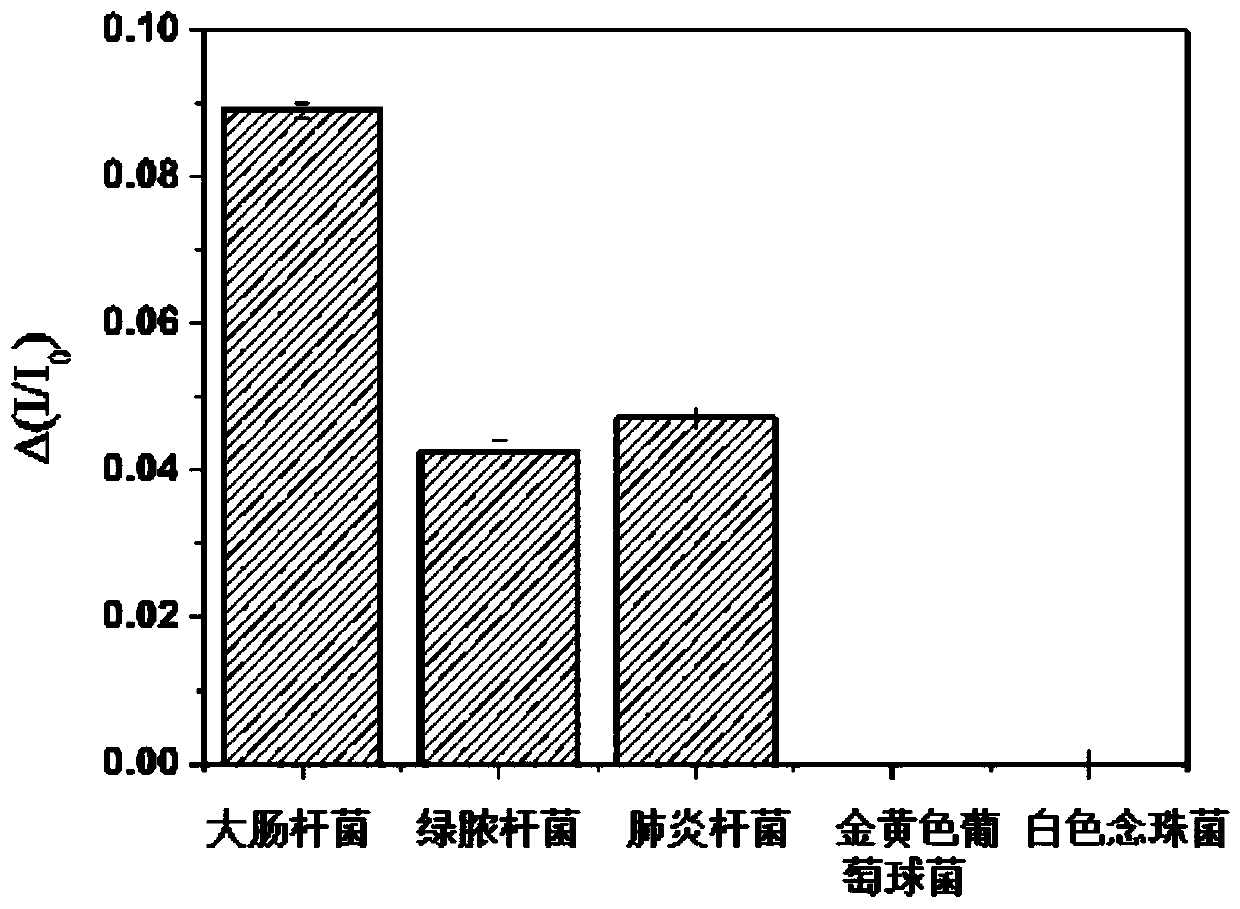A Surface Plasmon Resonance Sensor Chip for Gram-negative Bacteria Detection
A surface plasma, gram-negative bacteria technology, applied in measuring devices, instruments, scientific instruments, etc., to achieve the effects of easy synthesis, good reproducibility, and controllable structure
- Summary
- Abstract
- Description
- Claims
- Application Information
AI Technical Summary
Problems solved by technology
Method used
Image
Examples
Embodiment 1
[0053] A preparation method for Gram-negative bacteria detection surface plasmon resonance sensor chip, comprising the following steps:
[0054] (1) Gold is plated on the surface of the glass substrate, and the thickness of the gold film is 40nm;
[0055] (2) Soak the glass substrate obtained in step (1) in the compound S1 solution of 0.01mmol / L, let it stand for 1 hour, rinse it with water repeatedly, and set aside; wherein, the structure of compound S1 is:
[0056]
[0057] In the formula, Z and R are ester groups and amino groups respectively; the solvent of the compound S1 solution is physiological saline.
[0058] (3) Streptomycin sulfate, kanamycin sulfate and gentamycin sulfate probe molecules, NHS, EDC, HEPES buffer are mixed according to the molar ratio of 1:10:10:1 to obtain a mixed solution; (2) The obtained glass substrate is soaked in the mixed solution and left to stand for 2 hours;
[0059] (4) Take out the glass substrate, wash the glass substrate repeated...
Embodiment 2
[0061] A preparation method for Gram-negative bacteria detection surface plasmon resonance sensor chip, comprising the following steps:
[0062] (1) Gold is plated on the surface of the glass substrate, and the thickness of the gold film is 60nm;
[0063] (2) Soak the glass substrate obtained in step (1) in the compound S1-1 solution of 1000mmol / L, let it stand for 24 hours, rinse it repeatedly with distilled water, and set aside; wherein, the structure of compound S1-1 is:
[0064]
[0065] In the formula, the solvent of the compound S1-1 solution is acetonitrile
[0066] (3) Mix gentamicin sulfate probe molecules, NHS, EDC, and ethanol in a molar ratio of 1:100:100:1000 to obtain a mixed solution; soak the glass substrate obtained in step (2) in the mixed solution , stand still for 24 hours;
[0067] (4) Take out the glass substrate, rinse the glass substrate repeatedly with ethanol and distilled water, and obtain a surface plasmon resonance sensor chip for Gram-negativ...
Embodiment 3
[0069] A preparation method for Gram-negative bacteria detection surface plasmon resonance sensor chip, comprising the following steps:
[0070] (1) Gold is plated on the surface of the glass substrate, and the thickness of the gold film is 50nm;
[0071] (2) Soak the glass substrate obtained in step (1) in the compound S1-2 solution of 500mmol / L, let it stand for 12 hours, rinse it repeatedly with distilled water, and set aside;
[0072] Wherein, the structure of compound S1-2 is:
[0073]
[0074] The solvent of the compound S1-2 solution is chloroform;
[0075] (3) Mix the Genda-Pionomycin probe molecule, NHS, EDC, N,N-dimethylacetamide according to the molar ratio of 1:10:10:100 to obtain a mixed solution; the step (2) The obtained glass substrate was soaked in the mixed solution and left to stand for 12 hours;
[0076] (4) Take out the glass substrate, rinse the glass substrate repeatedly with ethanol and distilled water, and obtain a surface plasmon resonance senso...
PUM
| Property | Measurement | Unit |
|---|---|---|
| thickness | aaaaa | aaaaa |
| thickness | aaaaa | aaaaa |
| thickness | aaaaa | aaaaa |
Abstract
Description
Claims
Application Information
 Login to View More
Login to View More - R&D
- Intellectual Property
- Life Sciences
- Materials
- Tech Scout
- Unparalleled Data Quality
- Higher Quality Content
- 60% Fewer Hallucinations
Browse by: Latest US Patents, China's latest patents, Technical Efficacy Thesaurus, Application Domain, Technology Topic, Popular Technical Reports.
© 2025 PatSnap. All rights reserved.Legal|Privacy policy|Modern Slavery Act Transparency Statement|Sitemap|About US| Contact US: help@patsnap.com



